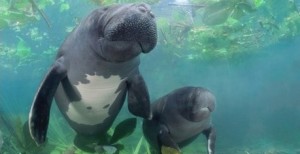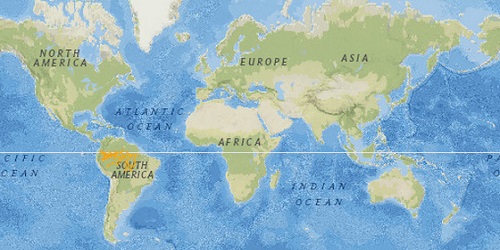Taxonomy
- Kingdom: Animalia
- Phyllum: Chordata
- Class: Mammalia
- Order: Sirenia
- Family: Trichechidae
- Genus: Trichechus
- Species: Trichechus inunguis
o
o
Name
- Common name: Amazonian manatee, South American manatee, Amazon sea cow.
- Scientific name: Trichechus inunguis.
Physical Features
- The Amazonian manatee is the smallest of the three living species of the Trichechus genus, the West Indian manatee (trichechus manatus) and the West African manatee (Trichechus senegalensis).
- Its skin color is gray with white markings on the abdomen and chest. Its rubbery skin is 2 inches thick (5 cm) and covered with fine hairs.
- They have thick bristles on the upper and lower lips.
- The Amazonian manatee has elongated flippers and lack nails. These are the main characteristics that differentiate the Amazonian manatee from the West Indian and West African manatees.
- Manatees have 6 neck vertebrae, all other mammals have 7.
Distribution and Habitat
- Amazonian manatees are distributed throughout the Amazon Basin covering an area of approximately 2.7 million sq miles (7 million sq km) in Brazil, Bolivia, Colombia, Ecuador and Peru.
- Their habitat includes the murky waters of rivers and lagoons and nutrient rich flooded forests.
- It is the only manatee that occurs exclusively in freshwater.
Behavior
- Manatees are very secretive and shy.
- They are both diurnal and nocturnal.
- During the rainy season they migrate to flooded areas and during the dry season to deeper bodies of water.
- They live in groups of 4 to 8 individuals.
- Females carry the young on their backs or clasped to their side.
- They eat mostly during the wet season. During the dry season they may not eat as much.
- Manatees never leave the water but have to swim to the surface to breath air.
- They are slow swimmers which makes them easy prey for hunters. They move at 5 mph (8 km/h) but can swim as fast as 15 mph (24 km/h) in short bursts.
Size and Weight
- The largest recorded Amazonian manatee was 9.2 feet (2.8 meters).
- The heaviest recorded was 836.5 lb (379.5 kg).
Reproduction
- Amazonian manatees breed throughout the year.
- In captivity they reach reproductive maturity at 2.5 years. It is unknown in the wild.
- Gestation period is 12 months and females give birth to one calf.
- Birth interval is 2 to 3 years.
- Manatees are born underwater, right after birth the mother has to push her newborn to the surface to breathe.
Diet
- This mammal is herbivorous and eats aquatic, semi aquatic plants and fallen fruit.
- They eat up to 8% of their body weight a day.
Life Expectancy
- An Amazonian manatee is expected to live an average of 12 years in captivity.
- Its life expectancy in the wild is unknown.
Predators
- Humans, jaguars, crocodiles.
Threats
- The IUCN predicts a population decline of at least 30% over the next 60 years.
- The Amazonian manatee has long been hunted by indigenous people for its meat and hide.
- Low birth rate, high calf mortality, climate change and habitat loss and degradation.
Conservation Status
- Trichechus inunguis is listed as Vulnerable by the IUCN Red List of Threatened Species.
- It is listed on Appendix I of CITES.
Did you know?
- Mixira is a popular dish in the Amazon and its main ingredient is manatee meat.
References and further research
IUCN Sirenia Speciealist Group
IUCN Red List of Threatened Species – Trichechus inunguis
American Society of Mammalogy – Trichechus inunguis
World Register of Marine Species
ITIS Report – Trichechus inunguis
Marine Species Identification Portal
University of Michigan Museum of Zoology – Trichechus inunguis


